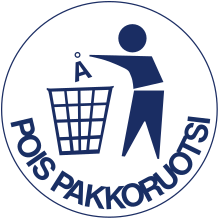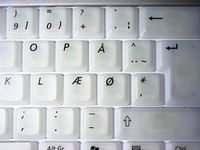Å
This articleneeds additional citations forverification.(August 2022) |
| A with Overring | |
|---|---|
| Å å | |
| ǻ | |
 | |
| Usage | |
| Writing system | Latin script |
| Language of origin | SwedishandDanish |
| Sound values | |
| InUnicode | U+00C5, U+00E5, U+212B |
| History | |
| Development | |
| Variations | ǻ |
| Other | |
The letterÅ(åin lower case) represents various (although often very similar)soundsin several languages. It is a separate letter inDanish,Swedish,Norwegian,Finnish,North Frisian,Low Saxon,Transylvanian Saxon,Walloon,Chamorro,Lule Sami,Pite Sami,Skolt Sami,Southern Sami,Ume Sami,Pamirian languages, andGreenlandicAlpha bets. Additionally, it is part of theAlpha betsused for someAlemannicandAustro-BavariandialectsofGerman.[1]
Though Å is derived fromAby adding anoverring,it is typically considered a separateletter.It developed as a form of semi-ligatureof anAwith a smalleroabove it to denote a rounding of the long /a/ inOld Danish.[2]
[edit]
Origin[edit]
The Å-sound originally had the same origin as the long/aː/sound inGermanAalandHaar(Scandinavianål,hår).
Historically, theåderives from theOld Norselong/aː/vowel (spelled with the letterá), but over time, it developed into an[ɔː]sound in most Scandinavian language varieties (in Swedish and Norwegian, it has eventually reached the pronunciation[oː]). Medieval writing often used doubled letters for long vowels, and the vowel continued to be written Aa.
InOld Swedishthe use of the ligatureÆand ofØ(originally also a variant of the ligature Œ) that represented the sounds[æ]and[ø]respectively were gradually replaced by new letters. Instead of using ligatures, aminuscule(that is, lower-case)Ewas placed above the lettersAandOto create newgraphemes,which later evolved into the modern lettersÄandÖ,as theEwas simplified into the two dots now referred to as anumlaut.Similarly, a minuscule O was placed on top of an A to create a new letter which was used in place of the digraphAa.It was first used inprintin theGustav Vasa Biblepublished in 1541 and replacedAain the 16th century.[3]
In an attempt to modernize the orthography, linguists tried to introduce the Å to Danish and Norwegian writing in the 19th century. Most people felt no need for the new letter, as the letter groupAahad already been pronounced like Å for centuries in Denmark and Norway. Aa was usually treated as a single letter, spoken like the present Å when spelling out names or words. Orthography reforms making Å official were carried out inNorwayin 1917 and inDenmarkin 1948. According to Jørgen Nørby Jensen, senior consultant atDansk Sprognævn,the cause for the change in Denmark was a combination of anti-German and pro-Nordic sentiment.[4]Danish had been the only language apart from German andLuxembourgishto usecapitalized nounsin the last decades, but abolished them at the same time.
In a few names of Danish cities or towns, the old spelling has been retained as an option due to local resistance, e.g.AalborgandAabenraa;however, Ålborg and Åbenrå are the spellings recommended by theDanish Language Board.[5]Between 1948 and 2010, the city ofAarhuswas officially spelledÅrhus.However, the city has reverted to theAaspelling starting 2011, in a controversial decision citing internationalization andwebcompatibility advantages.
IcelandicandFaroeseare the only North Germanic languages not to use theå.The Old Norse letteráis retained, but the sound it now expresses is a diphthong, pronounced[au]in Icelandic and[ɔa]in Faroese. The short variation of Faroese á is pronounced[ɔ],though.
Use in names[edit]
In some place names, the oldAaspelling dominates, more often in Denmark than in Norway (where it has been abolished in official use since 1917). Locals ofAalborgandAabenraaresist the Å, whereasÅlesundis rarely seen with Aa spelling. Official rules allow both forms in the most common cases, but Å is always correct. Å as a word means "small river" in Danish, Swedish, and Norwegian and can be found in place names.
Before 1917, when spelling with the double A was common, some Norwegian place names contained three or four consecutive A letters: for instanceHaaa(nowHåa,a river) andBlaaaasen(Blååsen,'the blue ( "blå" ) ridge ( "ås" )').
In family names, the bearer of the name uses Aa or Å according to their choice, but since family names are inherited they are resistant to change and the traditional Aa style is often kept. For instance, the last nameAagaardis much more common thanÅgård.The surname Aa is always spelled with double A, never with the singleå.However, given names - which are less commonly inherited - have largely changed to the use of the Å. For instance, in Norway more than 12,000 male citizens spell their nameHåkon,while only around 2,500 are namedHaakon.
Company names are sometimes spelled with the double A by choice, usually in order to convey an impression of old-fashionedness or traditionality. The double A, representing a single sound, is usually kept in initials e.g. for people whose first, middle, and/or last name begins with the double A. Accordingly, a man named "Hans Aagard Hauge" would spell his initials "H. Aa. H." (not "H. A. H." nor "H. Å. H." ), while a woman named Aase Vestergaard would spell her initials "Aa. V." (not "A. V." nor "Å. V." ).
Alphabetization[edit]
Danish and Norwegian[edit]
CorrectAlpha betizationinDanishandNorwegianplaces Å as the last letter in theAlpha bet,the sequence beingÆ,Ø,Å. This is also true for the alternative spelling "Aa". Unless manually corrected, sorting algorithms of programs localised for Danish or Norwegian will placee.g.,AaronafterZorro.
In Danish the correct sorting of aa depends on pronunciation: If the sound is pronounced as one sound it is sorted as Å regardless of the sound is 'a' or 'å'; thus, for example, the German cityAachenis listed underÅ,as well as the Danish cityAabenraa.This is §3 in the DanishRetskrivningsreglerne.[6]
Swedish[edit]
In theSwedishandFinnishAlpha bets, Å issortedafterZ,as the third letter from the end, the sequence being Å,Ä,Ö.This is easiest to remember across the Nordic languages, that Danish and Norwegian follow Z first with E-mutated letters Æ and Ø and then the symbol with a one-stroke diacritic Å. Swedish and Finnish follow Z with a one-stroke diacritic Å and then a two-stroke (or two-dot) diacritic Ä, Ö. A combined Nordic sorting mnemonic is Æ, Ø, Å, Ä, Ö.
International transcription[edit]
Alternative spellings of the Scandinavian Å have become a concern because of globalization, and particularly because of the popularization of theWorld Wide Web.This is to a large extent due to the fact that prior to the creation ofIDNAsystem around 2005, internet domains containing Scandinavian letters were not recognized by theDNS,and anyway do not feature on keyboards adapted for other languages. While it is recommended to keep the Å intact wherever possible, the next best thing is to use the older, double A spelling (e.g. "raade" instead of "råde" ). This is because, as previously discussed, the Å/Aa indicates a separate sound. If the Å is represented as a common A without the overring (e.g. "rade" ) there is no indication that the A is supposed to represent another sound entirely. Even so, representing the Å as just an A is particularly common in Sweden, as compared to Norway and Denmark, because the spelling Aa has no traditional use there.
Finnish[edit]

Because theFinnish Alpha betis derived from the Swedish Alpha bet, Å is carried over, but it has no native Finnish use and is treated as in Swedish. Its usage is limited to loanwords (the Finnish academic dictionaryKielitoimiston sanakirja,about 100,000 words, has only one word containing Å:ångström) and names of Swedish, Danish or Norwegian origin. In Finland there are many Swedish-speaking as well as many Finnish-speaking people with Swedish surnames, and many Swedish surnames include Å. In addition, there are many geographical places in the Finnish coastal areas and archipelago that have å in their Swedish names, such asKråköandLångnäs,as well as the Finnish autonomic region ofÅland,a group of islands midst between Sweden and Finland where almost all natives speak Swedish. The Finnish name for Å isruotsalainen O( "Swedish O" ), and is pronounced identically toO,which has the value[o̞].(Note that in Swedish, theOis pronounced differently,[o].)
It is not allowed to substituteaaforåin Finnish, asaais already a common letter combination with the value[ɑː].
Emilian[edit]
InEmilian,å is used to represent theopen-mid back unrounded vowel[ʌ],e.g. Modenese dialectåmm,dånna [ˈʌmː],[ˈdʌnːa]"man, woman";
e.g. Bolognese dialectBulåggna,dåpp [buˈlʌɲːa][ˈdʌpː]"Bologna,later ".
Walloon[edit]
The letter å was introduced to some eastern local variants ofWalloonat the beginning of the 16th century and initially noted the same sound as in Danish. Its use then spread to all eastern dialects, under the cultural influence ofLiege,and covered three sounds, a long openo,a long closedo,or a longa,depending on the local varieties. The use of a singleåletter to cover such pronunciations has been embraced by the more recent pan-Walloonorthography,with one orthography for words regardless of the local phonetic variations.
In non-standardized writings outside the Liege area, words containingåare written withau/ô(representing the same sound) orâ.For example, the wordmåjhon(house) in the standardized orthography is spelledmôjo(n),mâhon,maujonin dialectal writings (mohoneis another form that does not contain a long å).
Istro-Romanian[edit]
TheIstro-RomanianAlpha bet is based on the standardRomanian Alpha betwith three additional letters used to mark sounds specific only to this language: å, ľ and ń.
Javanese[edit]
Javaneseuses å to indicateopen-mid back rounded vowel⟨ɔ⟩ together with ó (o acute).
Chamorro[edit]
Å andåare also used in the practical orthography ofChamorro,a language indigenous to the people ofNorthern Mariana IslandsandGuam.The Chamorro name for Guam isGuåhån,and its capital is calledHagåtña.[7]
Greenlandic[edit]
InGreenlandic,åis not used in native words, but is used in several loanwords from Danish, such asbåndoptageri(Danishbåndoptager) 'tape recorder'. Like in Danish,åis sorted last in the Alpha bet.
Symbol for ångström[edit]
The letter "Å" (U+00C5) is also used as the international symbol for the non-SIunitångström,aphysical unitoflengthnamed after theSwedishphysicistAnders Jonas Ångström.It is alwaysuppercasein this context (symbols for units named after persons are generally uppercase). The ångström is equal to10−10m(one ten-billionth of a meter) or0.1 nm.
InUnicode,the unit is encoded asU+212BÅANGSTROM SIGN.However, it iscanonically equivalentto the ordinary letter Å. The duplicate encoding at U+212B is due to round-trip mapping compatibility with an East-Asiancharacter encoding,but is otherwise not to be used.[8]
On computers[edit]

On Norwegian keyboards the Æ and Ø trade places.
| Preview | Å | å | Å | |||
|---|---|---|---|---|---|---|
| Unicode name | LATIN CAPITAL LETTER A WITH RING ABOVE | LATIN SMALL LETTER A WITH RING ABOVE | ANGSTROM SIGN | |||
| Encodings | decimal | hex | dec | hex | dec | hex |
| Unicode | 197 | U+00C5 | 229 | U+00E5 | 8491 | U+212B |
| UTF-8 | 195 133 | C3 85 | 195 165 | C3 A5 | 226 132 171 | E2 84 AB |
| Numeric character reference | Å |
Å |
å |
å |
Å |
Å |
| Named character reference | Å, Å | å | ||||
| EBCDICfamily | 103 | 67 | 71 | 47 | ||
| ISO 8859-1/9/10/13/14/15 | 197 | C5 | 229 | E5 | ||
| alt code | Alt+143 | Alt+134 | ||||
| Mac keycode | ⌥Option+⇧ Shift+a | ⌥Option+a | ||||
| TeX | \AA | \aa | ||||
Similarly styled trademarks[edit]
Thelogoof theMajor League Baseballteam known as theLos Angeles Angelsis a capital "A" with a halo. Due to the resemblance, some Angels fans stylize the name as "Ångels".
The logo of theStargateseries similarly features a stylized A with a circle above it, making it resemble an Å as in Stargåte; in Norwegian,gåtemeans "riddle".
Cirque du Soleil's Koozå production uses this character in its logo, although it is pronounced by the main singer as a regular "a".
British producer and singerLåpsleyuses it in her stage name.
See also[edit]
- Æ
- Ä
- Á
- A with ring above (Cyrillic),aSelkup languageletter
- Ø
- Ö
- Combining character(A and combining ring above (U+030A), Å å, or o above (U+0366), Aͦ aͦ, resembles Å å)
Notes[edit]
- ^The Sound of the Austro-Bavarian language- Salzburg dialect (Numbers, Greetings & Story).Retrieved2024-04-01– via youtube.
- ^Sandersen, Vibeke (2002)."Om bogstavet å"(PDF).Ny fra Sprognævnet.September.Retrieved8 June2024.
- ^Pettersson (1996), p. 139
- ^Karen Munk Ebbesen (22 March 2018)."70 år uden dobbelt-a – bolle-å fylder rundt".tv2.dk.Retrieved14 April2021.
- ^Orthography rules, §3.2Archived2010-05-13 at theWayback Machine,sproget.dk (in Danish)
- ^https://dsn.dk/ordboeger/retskrivningsordbogen/%c2%a7-1-6-bogstaver-og-tegn/%c2%a7-3-aa-og-dobbelt-a/
- ^"Chamorro Orthography Rules".Guampedia.Archived fromthe originalon 22 September 2020.Retrieved20 August2020.
- ^Gillam, Richard (2003).Unicode Demystified: A Practical Programmer's Guide to the Encoding Standard.Addison-Wesley Professional. p. 74.ISBN9780201700527.
References[edit]
- Pettersson, Gertrud (1996),Svenska språket under sjuhundra år: en historia om svenskan och dess utforskande,Lund:Studentlitteratur,ISBN91-44-48221-3

